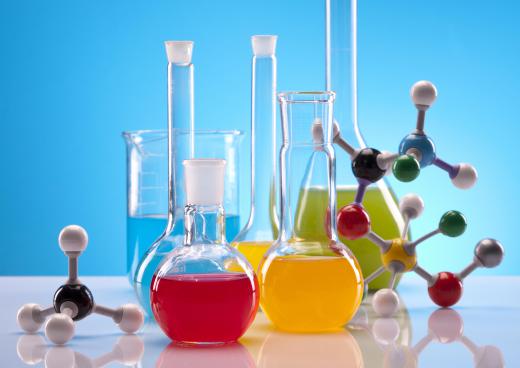What is Molecular Chemistry?
 Michael Anissimov
Michael Anissimov
Molecular chemistry is the chemistry of molecules, which covers most of chemistry as a whole. Molecules are made up of various combinations of atoms, the fundamental building blocks of everything around us. There are 92 elements that occur naturally on Earth, in addition to 25 artificial elements, which are created in small quantities in particle accelerators and nuclear reactors. Out of the 92 natural elements, various arrangements of 12 make up 99% of all rocks and soil, while arrangements of 5 make up 99.97% of the atmosphere. Other elements are found in trace amounts, usually one part per million or less.
The fundamentals of molecular chemistry are based on qualities of atoms called valence. Every atom is made up of little particles called electrons orbiting a nucleus made of particles called protons and neutrons. These electrons orbit is "shells" designated by the laws of physics -- the first shell has a capacity of two electrons, the second has a capacity of 6, the third 10, the fourth 14, the fifth 18, the sixth 22, and the seventh 26.

If an atom has "too few" electrons, such that its outermost electron shell (also known as an orbital) has more or less than eight electrons, it "wants" to either get rid of electrons or gain them by bonding with another atom. The tendency to "want" eight electrons in the outermost shell, the same number as found in noble gases like helium (the most stable elements), is called the octet rule, a basic fact of molecular chemistry. These forces are dictated by the laws of electromagnetism.

To visualize molecular chemistry, here's an example. A common molecule is salt, NaCl, or sodium chloride. Salt consists of two atoms locked to each other in an atomic bond. Sodium's outermost electron shell has just one electron, but has a capacity for ten. Chlorine's outermost shell has seven electrons, but a capacity for ten. When the two bond together, they get eight electrons in their collective outermost shell, satisfying the octet rule. The octet rule is fulfilled in countless molecules. These bonds can easily be represented in pictures using Lewis dot diagrams.
When atoms combine together in stable structures, they form molecules, which are also called compounds. Pure compounds or mixtures of compounds with uniform properties are called a substance. The compounds in a substance can interact with other compounds, giving rise to situations called chemical reactions. Chemical reactions are constantly ongoing all around us, especially in our bodies, which are veritable cauldrons of chemical reactions. When we eat food, it's to provide our body with molecules that can undergo chemical reactions to release energy for its operation.
AS FEATURED ON:
AS FEATURED ON:












Discussion Comments
My name is Mark and i would just like to say that i have developed a water that can hold a conductivity level of 1200 microsiemens for six months (electrolytically enhanced water). I would like to see if anyone can work out why my water holds it for that long as normally water would only hold its polarity for a couple of hours. This water has amazing energy and hydration levels. Regards, Mark
Post your comments